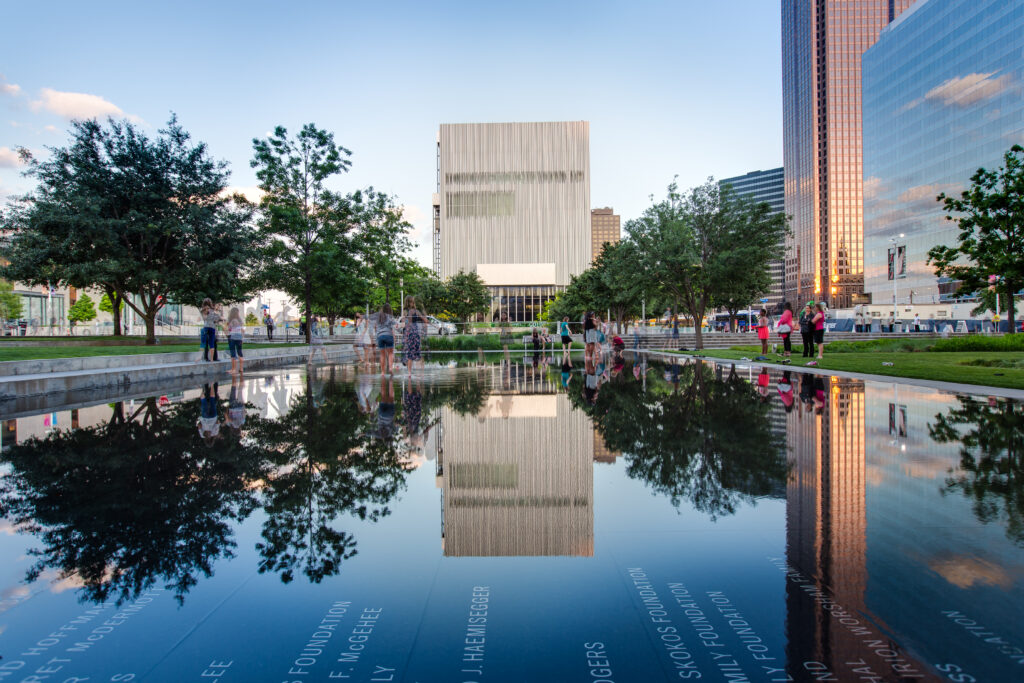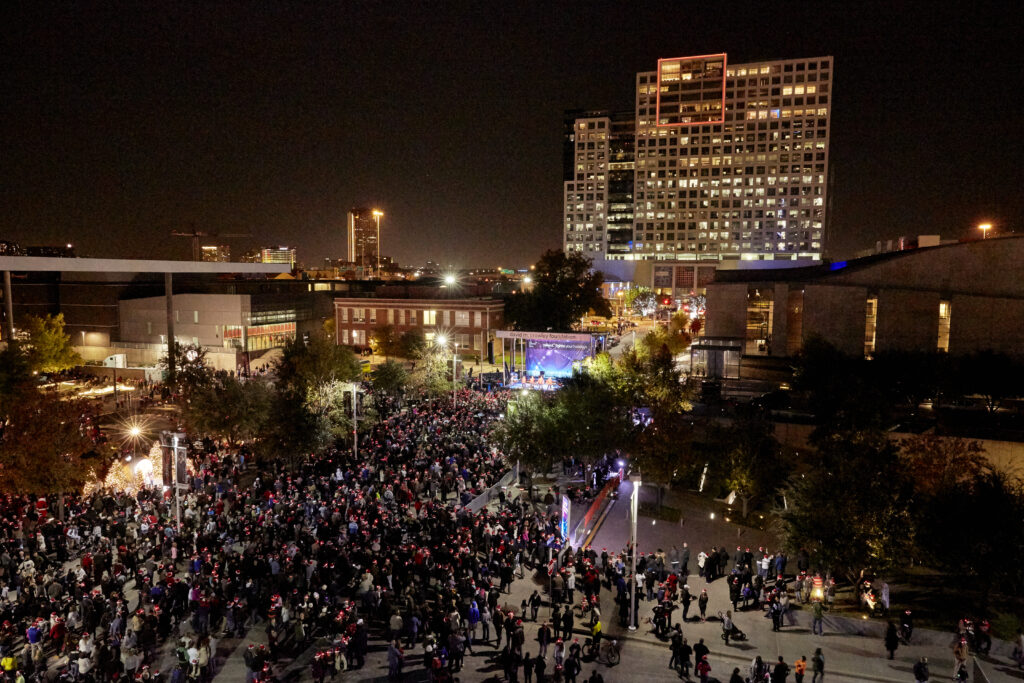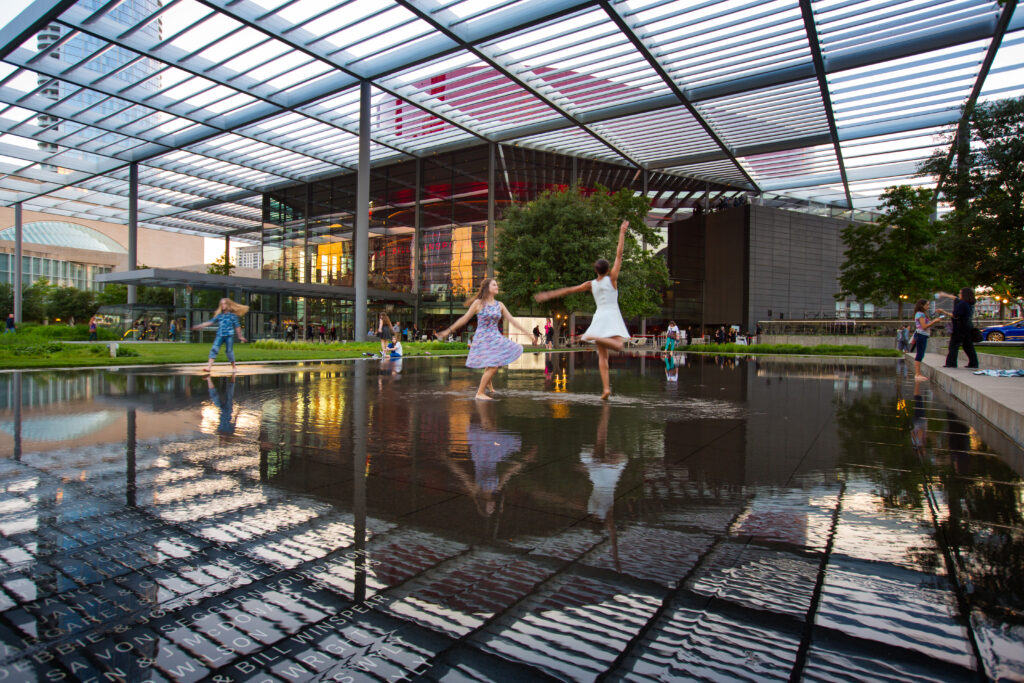Connecting the Arts District to Its Promise

On a summer Friday, some girlfriends and I were going to make an evening of it. We planned to meet for dinner at a restaurant in the Arts District, followed by a comedy show at the Winspear Opera House. Being an employee of the Dallas Museum of Art, I kept my car parked in the DMA garage and headed out in sweltering heat to walk the few blocks to the restaurant.
Once beyond my cozy nest of Harwood and lower Flora Street, I passed several dark storefronts housing nondescript businesses and optimistically pondered future tenants that might soon occupy the street- level retail shops in the new Atelier building. Lost in thought, I quickly regained consciousness upon approaching Pearl and Flora; traversing this intersection requires a quick foot, lightning reflexes, and a quiet prayer that you make it across before the walk timer runs out (usually halfway across six lanes of Pearl) or before a car racing to beat a red-light zigzags around you. I reached the restaurant and waited for my friends, who took a ride- share since public transportation doesn’t provide an easy stop in the area. We enjoyed our dinner, paying a hefty sum for sushi and drinks (one of only a few dining options, none of which could be considered affordable), and walked to the Winspear. The show was fabulous — the comedian was hilarious, we enjoyed our time together, we ran into some acquaintances at the venue, and then the evening ended. My friends caught another car, I walked back to the museum and got mine, and, as I sat in the traffic jam blocking all of the small streets leading onto Woodall Rodgers, I thought about my night.
What made the evening so enjoyable was seeing friends and sharing a meal and a fun performance. But did I need to go to the Arts District to do that? If the comedian had played elsewhere, we would have gone there. The traffic jam made it clear that, despite being a Friday evening, there wasn’t anything in the immediate neighborhood that compelled us to stay and further enjoy the night and the neighborhood.
And yet we were in the middle of what the Dallas Arts District Connect Master Plan calls “the largest contiguous urban arts district in the nation” and had sat in a beautiful building designed by a world-famous architect, surrounded by several other beautiful buildings designed by several other world-famous architects. Shouldn’t that count for something?


The Beginning
The Arts District of today is the result of years of thinking, planning, consulting, designing, and building. Walking through the neighborhood, it gives off a palpable air of intentionality; little seems haphazardly planned.
When the Arts District was conceived in the late 1970s, local developers and city officials were seeking ways to bring more life to the city core. Downtown had become a 9-to-5 business district with blurry boundaries and little incentive to stick around past quitting time. Cultural amenities were scattered throughout the city, with the Dallas Theater Center in Turtle Creek, the Dallas Museum of Fine Arts in Fair Park, and no symphony hall – the true symbol of a city on the rise. Despite the fact that Dallas had an orchestra, it had no permanent home, and other arts organizations had small or temporary homes.
The decision to develop an arts district as a method to galvanize the city’s residents and bring them back downtown began with the hiring of urban design consultants Carr Lynch Associates of Massachusetts. It assessed the space needs of Dallas’ cultural institutions, then issued the report A Comprehensive Arts Facilities Plan for Dallas in 1977. The Dallas Museum of Art board had already found the appropriate property, settling on the site where the DMA sits today.
While it was to become one of two anchors for the future development and was close enough to what might be considered the downtown core (A quote from the report put it succinctly: “Dallas still had no general downtown focal point – no ‘corner of Main and Main.’ ”), the plan for the Arts District focused on the human experience, with the idea that it would become a “people place.”
As excerpted from the report, in the Dallas Arts District handbook issued in September 1984, the neighborhood would become:
A territory which belongs to all [population] groups in the city, and which has excellent automobile access and the best public transportation in the city (99 of the city’s 101 bus routes pass through it). Over 100,000 people who work in the CBD [Central Business District] are a large potential daytime audience, to which may be added a heavy flow of convention visitors. Conversely, the arts institutions will help to balance the present office and shopping use of downtown with leisure time and nighttime events, benefiting workers and shoppers in the core, reviving the old Dallas tradition of going downtown for entertainment, and supporting further private development there. If the major arts institutions cluster downtown, they will in themselves provide an important tourist attraction and help to strengthen convention activity.
Among the neighborhood’s tenants at the time, the Cathedral Santuario de Guadalupe and St. Paul United Methodist Church, the second oldest Black church in Dallas, were vibrant, well-attended religious institutions and seen as integral to the formation of a diverse, dynamic range of building and program types. The neighborhood public high school was shifting to become a magnet school focused on the arts, bringing in even more traffic for the fledgling concept. With new office buildings that would punctuate the enclave of performance spaces, pedestrian foot traffic was guaranteed to be the driving force that would complete the concept.
The Present
The Carr-Lynch report and the Sasaki Plan, the master plan developed by Sasaki Associates in 1982, both laid out clear, community-focused, engaging visions that would provide multiple modes of entertainment, retail, shopping, and opportunities for chance encounters. According to the Sasaki Plan, the Arts District was to be a place where “artists, performers, visitors, workers, residents, and patrons of the arts may attend ‘hands-on’ pottery workshops, negotiate a business deal, savor Texas chili or Coquilles St. Jacques, muse over the meaning of a contemporary dance performance or an African sculpture, purchase Dallas souvenirs or additions to an art collection, or meander through trees along the street exchanging pleasantries with patrons of a sidewalk cafe.” It would be a place where both the “sophisticated and the uninitiated” would be welcomed.
It cannot necessarily be argued that the buildings constructed since the report don’t strive for that level of engagement; certainly the grand stair in the Winspear Opera House provides a see-and-be-seen opportunity for all who walk through the building’s doors, in the grand tradition of opera houses in Europe; the social stair in front of OMA’s Wyly Theatre is yearning for visitors to sit and chat before or after a performance; and the dining establishments in One Arts Plaza would love a crowd of post-performance patrons. The pieces are there, but is this the Arts District that it was meant to be?
While the stunning architectural monuments to art and culture provide these opportunities in the very academic sense, confusion remains as to what it is we are supposed to be doing here. What exactly is the Arts District, and what does it want to be? Is it meant to engage beyond the limits of the performances? The few restaurants in One Arts and scattered along Flora indicate that yes, you are meant to socialize and spend time enjoying yourself. But the campus-like feel of the Flora spine and the grand buildings that form the edges preclude that critical missing piece: connection.
The Future
Enter the Dallas Arts District Connect Master Plan. Developed in partnership with Alex Krieger and Alan Mountjoy of NBBJ in Boston and with the Dallas Arts District, the plan “is to guide the design and construction of new and replacement features in the Dallas Arts District” to support the five pillars of its mission: collaboration, education, community, inclusion, and innovation. The plan acknowledges the district’s “institutional and architectural accomplishment” but says work “must now continue to reach for equally exemplary urban experience.”
In coming to terms with the idea that the built environment, while crucial, took precedence over the people-first nature of the original Sasaki plan, it is easier to see the spatial and social ambiguity in person.
Among its top priorities, the plan aims to improve the physical connections to surrounding downtown neighborhoods.
Lucilo Peña, president of development at Billingsley Company and a member of the Dallas Arts District Infrastructure Committee, and Lily Weiss, executive director of the Dallas Arts District, are working to address these priorities.
“I remember when Alex Krieger said that the Arts District needs to tear down its walls physically and metaphorically with connectivity, safety, accessibility as a priority,” Weiss says.
“Klyde Warren [Park] has been terrific in that it has connected Uptown to downtown, and it was connected at grade-level. But I refer to the highways around our neighborhoods as medieval walls; they isolate us from everything around us and challenge connectivity,” Peña says.
Given the challenges of tearing down highways, the question becomes: How do we emphasize the connectivity of some of the underpasses?
The most accessible solution presented itself in the modernization and improvement of the Routh Street underpass. The Routh Street Gateway plan connects the Arts District at Routh Street. Designed over the last six years and now being implemented pro bono by Balfour Beatty, Corgan, and AECOM, this project is one of the first measures to make it safer and more inviting for pedestrians to enter the Arts District. Enhanced lighting, limestone blocks as buffers from traffic, and new signs are meant to act in tandem and create a link to Uptown. In addition, further partnerships with Billingsley, Downtown Dallas Inc., and Uptown Dallas, as well as bonds from the city, have helped foster the improvements.
But it’s not just connections to Uptown getting the attention. Weiss and Peña also recognize the importance of their neighbors on the southern edge.
“We were the first to know that we turned our backs on a very important street, Ross Avenue,” Weiss says.
The developments along Ross in recent years are noticeable. Starting with the renovation and redevelopment of the Trammell Crow Center, the neighborhood has seen options for dining and retail open up, with new opportunities for interaction and casual activity. Simply by broadening the visibility at Ross and creating more permeable physical spaces, that feeling of a turned back and hard edges is softening. While establishing more robust development for Ross is covered in the Connect plan, there are many improvements still to be made. The plan suggests adopting recommendations from the Downtown Dallas 360 Plan that outline “increasing pedestrian and bike access on Ross Avenue by reducing the width of the existing vehicle lanes,” as well as establishing development guidelines that call for “ground-level setbacks to ensure a more continuous street wall of active uses.”
These are just two of five goals outlined in the Connect plan, which is worth reading. Weiss is fully aware of the challenges and shortcomings that the district has seen over the years.
“We have more to accomplish in creating a vibrant cultural neighborhood where residents and visitors come on a regular basis,” she says. She wants the Arts District to be seen as belonging to the entire city, not just as an area hugging downtown, and expects the programming and the offerings to act as a catalyst and connector.
“I hope what we’re doing is what the title of our masterplan suggests, to connect,” she says. “The future looks bright.”
Kate Aoki, AIA is head of exhibition design at the Dallas Museum of Art and president of AIA Dallas.